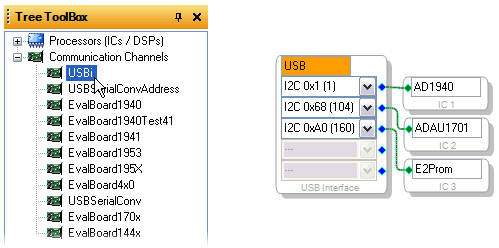ADAU1442
PRODUCTIONSigmaDSP® Digital Audio Processor with Flexible Audio Routing Matrix
- Part Models
- 2
- 1ku List Price
- Starting From $10.10
Overview
- Fully programmable audio digital signal processor (DSP) for enhanced sound processing
- Features SigmaStudio™, a graphical programming tool for development of custom signal flows
- 172 MHz SigmaDSP core; 3584 instructions/sample @ 48 kHz
- 4k Parameter RAM, 8k Data RAM
- Supports 24 channels of serial and TDM I/O, up to fs = 192 kHz
- See data sheet for additional information
The ADAU1442 / ADAU1445 / ADAU1446 are enhanced audio processors that allow full flexibility in routing all input and output signals. The SigmaDSP® core features full 28-bit processing (56-bit in double-precision mode), synchronous parameter loading for ensuring filter stability, and 100% code efficiency with the SigmaStudio™ tools. This DSP allows system designers to compensate for the real-world limitations of speakers, amplifiers, and listening environments, resulting in a dramatic improvement of the perceived audio quality through speaker equalization, multiband compression, limiting, and third-party branded algorithms.
The flexible audio routing matrix (FARM) allows the user to multiplex inputs from multiple sources running at various sample rates to or from the SigmaDSP core. This drastically reduces the complexity of signal routing and clocking issues in the audio system. FARM includes up to eight stereo asynchronous sample rate converters (depending on the device model), Sony/ Philips Digital Interconnect Format (S/PDIF) input and output, and serial (I2S) and time division multiplexing (TDM) I/Os. Any of these inputs can be routed to the SigmaDSP core or to any of the asynchronous sample rate converters (ASRCs). Similarly, any one of the output signals can be taken from the SigmaDSP core or from any of the ASRC outputs. This routing scheme, which can be modified at any time via control registers, allows for maximum system flexibility.
The ADAU1442, ADAU1445, and ADAU1446 differ only in ASRC functionality and packaging. The ADAU1442 / ADAU1445 contain 16 channels of ASRCs and are packaged in TQFP packages, whereas the ADAU1446 contains no ASRCs and is packaged in an LQFP. The ADAU1442 can handle nine clock domains, the ADAU1445 can handle three clock domains, and the ADAU1446 can handle one clock domain.
The ADAU1442 / ADAU1445 / ADAU1446 can be controlled in one of two operational modes: the settings of the chip can be loaded and dynamically updated through the SPI/I2C® port, or the DSP can self-boot from an external EEPROM in a system with no microcontroller. There is also a bank of multipurpose (MP) pins that can be used as general-purpose digital I/Os or as inputs to the 4-channel auxiliary control ADC.
The ADAU1442 / ADAU1445 / ADAU1446 are supported by the SigmaStudio graphical development environment. This software includes audio processing blocks such as FIR and IIR filters, dynamics processors, mixers, low level DSP functions, and third-party algorithms for fast development of custom signal flows.
APPLICATIONS
- Automotive audio processing
Head units
Navigation systems
Rear-seat entertainment systems
DSP amplifiers (sound system amplifiers) - Commercial audio processing
Documentation
Data Sheet 1
User Guide 1
Application Note 3
Frequently Asked Question 1
Device Drivers 1
ADI has always placed the highest emphasis on delivering products that meet the maximum levels of quality and reliability. We achieve this by incorporating quality and reliability checks in every scope of product and process design, and in the manufacturing process as well. "Zero defects" for shipped products is always our goal. View our quality and reliability program and certifications for more information.
| Part Model | Pin/Package Drawing | Documentation | CAD Symbols, Footprints, and 3D Models |
|---|---|---|---|
| ADAU1442YSVZ-3A | 100-Lead TQFP (14mm x 14mm w/ EP) | ||
| ADAU1442YSVZ-3A-RL | 100-Lead TQFP (14mm x 14mm w/ EP) |
| Part Models | Product Lifecycle | PCN |
|---|---|---|
|
Jun 22, 2015 - 14_0259 Assembly Transfer of Select 10x10 and 14x14 TQFP_EP Products to Amkor Philippines |
||
| ADAU1442YSVZ-3A | PRODUCTION | |
| ADAU1442YSVZ-3A-RL | PRODUCTION | |
|
Jan 5, 2009 - 07_0077 Certification of STATSChipPAC Shanghai, China and AMKOR Philippines as additional sources for Assembly & Test of QFP Packages |
||
| ADAU1442YSVZ-3A | PRODUCTION | |
| ADAU1442YSVZ-3A-RL | PRODUCTION | |
|
Mar 15, 2016 - 14_0258 Assembly Transfer of Selected 14x14 LQFP, 14x14 LQFP_EP and 7x7,10x10,12x12,14x14 TQFP_EP Products to Amkor Philippines |
||
| ADAU1442YSVZ-3A-RL | PRODUCTION | |
This is the most up-to-date revision of the Data Sheet.
Software Resources
Device Drivers 1
SigmaStudio®
Graphical development tool for programming, development, and tuning software for ADI DSP audio processors and A2B® transceivers.
View DetailsEvaluation Software 0
Can't find the software or driver you need?
Hardware Ecosystem
| Parts | Product Life Cycle | Description |
|---|---|---|
| Analog to Digital Converters (ADCs) 1 | ||
| ADMP441 | Obsolete | Omnidirectional Microphone with Bottom Port and I2S Digital Output |
| Digital to Analog Converters (DACs) 1 | ||
| ADAU1966 | NOT RECOMMENDED FOR NEW DESIGNS | 16-Channel 118 dB SNR Differential Output, 192 kHz, 24-Bit DAC |
Tools & Simulations
ADAU144x IBIS Models 1
SigmaDSP Processors: Software and Tools
Open Tool



